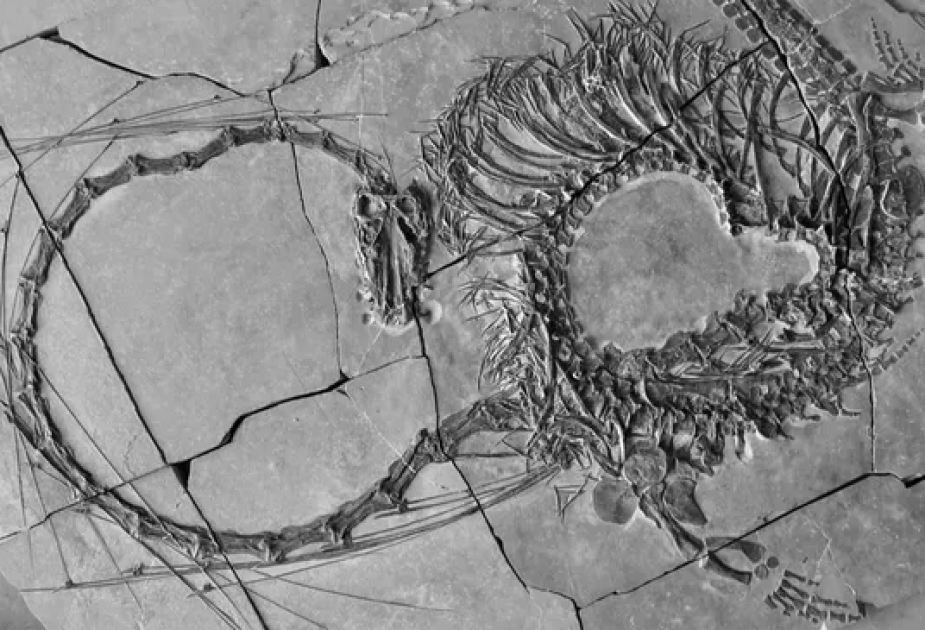|
|
TODAY.AZ / World news
Stunning 240 million-year-old 'Chinese dragon' fossil unveiled by scientists
25 February 2024 [20:20] - TODAY.AZ

Scientists have unveiled stunning fossils of an ancient seaborne "dragon" discovered in China, Azernews reports citing Live Science.
The 240 million-year-old animal — nicknamed the "Chinese dragon" — belongs to the species Dinocephalosaurus orientalis, a reptile that used its remarkably long neck to ambush unsuspecting prey in shallow waters during the Triassic period (252 million to 201 million years ago).
The species was first found in limestone deposits in southern China in 2003, but scientists have now pieced together remains to reconstruct the full 16.8-foot (5 meters) span of the spectacular ancient carnivore for the first time.
The researchers revealed the new findings in a study published Feb. 23 in the journal Earth and Environmental Science: Transactions of the Royal Society of Edinburgh.
"It is yet one more example of the weird and wonderful world of the Triassic that continues to baffle paleontologists," Nick Fraser, keeper of natural sciences at National Museums Scotland said in a statement. "We are certain that it will capture imaginations across the globe due to its striking appearance, reminiscent of the long and snake-like, mythical Chinese Dragon."
The fossil reveals some of the ancient sea dragon's striking features.
First and foremost is its neck, which stretches nearly 7.7 feet (2.3 meters) and contains 32 separate vertebrae — in comparison, giraffes (as well as humans) have only seven neck vertebrae.
The snake-like shape of the dragon's articulable neck likely gave it a remarkable ability to sneak up on its prey, which it did after maneuvering into position with its flippered limbs. Some of the fish snared in the dragon's serrated teeth are still preserved inside the sea monster's belly.
The researchers note that though the strange creature may be reminiscent of the Loch Ness Monster, it is not closely related to the long-necked plesiosaurs that inspired the famous mythical creature.
"We hope that our future research will help us understand more about the evolution of this group of animals, and particularly how the elongate neck functioned," first-author Stephan Spiekman, a postdoctoral researcher based at the Stuttgart State Museum of Natural History, said in the statement.
URL: http://www.today.az/news/regions/245311.html
 Print version
Print version
Connect with us. Get latest news and updates.
See Also
- 19 December 2024 [23:51]
Alcohol-related deaths in England reach record levels - 19 December 2024 [23:30]
Yuan surpasses the yen in popularity in SWIFT - 19 December 2024 [22:28]
Türkiye’s disinflation goals on track amid tight monetary policy - 19 December 2024 [21:42]
Pentagon estimates number of Chinese nuclear warheads at more than 600 units - 19 December 2024 [21:25]
Istanbul, Abu Dhabi financial centers ink cooperation deal - 19 December 2024 [20:50]
Massive loss of seabirds in Alaska occurres after heat wave in Pacific Ocean - 19 December 2024 [20:24]
Minister Bolat highlights Turkiye's economic growth and trade achievements - 19 December 2024 [19:43]
Decision on TikTok can be cancel in USA - 19 December 2024 [19:21]
Ankara makes milestone signing historic defense agreement with Portugal - 19 December 2024 [18:50]
US calls F-35 fighter jet project failure
Most Popular
 More Armenians fly: the crisis of power in Canada
More Armenians fly: the crisis of power in Canada
 Azerbaijan, Colombia Discuss Cooperation in Various Fields
Azerbaijan, Colombia Discuss Cooperation in Various Fields
 Azerbaijani delegation participates in internet governance forum in Riyadh
Azerbaijani delegation participates in internet governance forum in Riyadh
 Armenian militant group threatens regional stability aligning with PKK/YPG in new ground
Armenian militant group threatens regional stability aligning with PKK/YPG in new ground
 Lapshin shows up, again collecting alms from naive Armenians
Lapshin shows up, again collecting alms from naive Armenians
 Rubik Vardanyan surprises his own lawyers
Rubik Vardanyan surprises his own lawyers
 Azerbaijan's role in COP29 highlights growing global influence, says MEDIA Director
Azerbaijan's role in COP29 highlights growing global influence, says MEDIA Director
